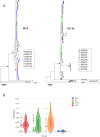Permanent control of HIV-1 pathogenesis in exceptional elite controllers: a model of spontaneous cure
- PMID: 32024974
- PMCID: PMC7002478
- DOI: 10.1038/s41598-020-58696-y
Permanent control of HIV-1 pathogenesis in exceptional elite controllers: a model of spontaneous cure
Abstract
Elite controllers (EC) represent a small subset of HIV-1-infected people that spontaneously control viral replication. However, natural virological suppression and absence of immune dysfunction are not always long-term sustained. We define exceptional EC (EEC) as HIV-1 subjects who maintain the EC characteristics without disease progression for more than 25 years. We analyzed three EEC, diagnosed between 1988 and 1992, who never showed signs of clinical disease progression in absence of any antiretroviral treatment. A comprehensive clinical, virological, and immunological study was performed. The individuals simultaneously exhibited ≥3 described host protective alleles, low levels of total HIV-1 DNA (<20 copies/106 CD4+ T-cells) without evidence of replication-competent viruses (<0.025 IUPM), consistent with high levels of defective genomes, strong cellular HIV-1-specific immune response, and a high poly-functionality index (>0.50). Inflammation levels of EEC were similar to HIV-1 negative donors. Remarkably, they showed an exceptional lack of viral evolution and 8-fold lower genetic diversity (<0.01 s/n) in env gene than other EC. We postulate that these EEC represent cases of spontaneous functional HIV-1 cure. A non-functional and non-genetically evolving viral reservoir along with an HIV-1-specific immune response seems to be key for the spontaneous functional cure.
Conflict of interest statement
The authors declare no competing interests.
Figures




References
Publication types
MeSH terms
Grants and funding
LinkOut - more resources
Full Text Sources
Medical
Molecular Biology Databases
Research Materials

